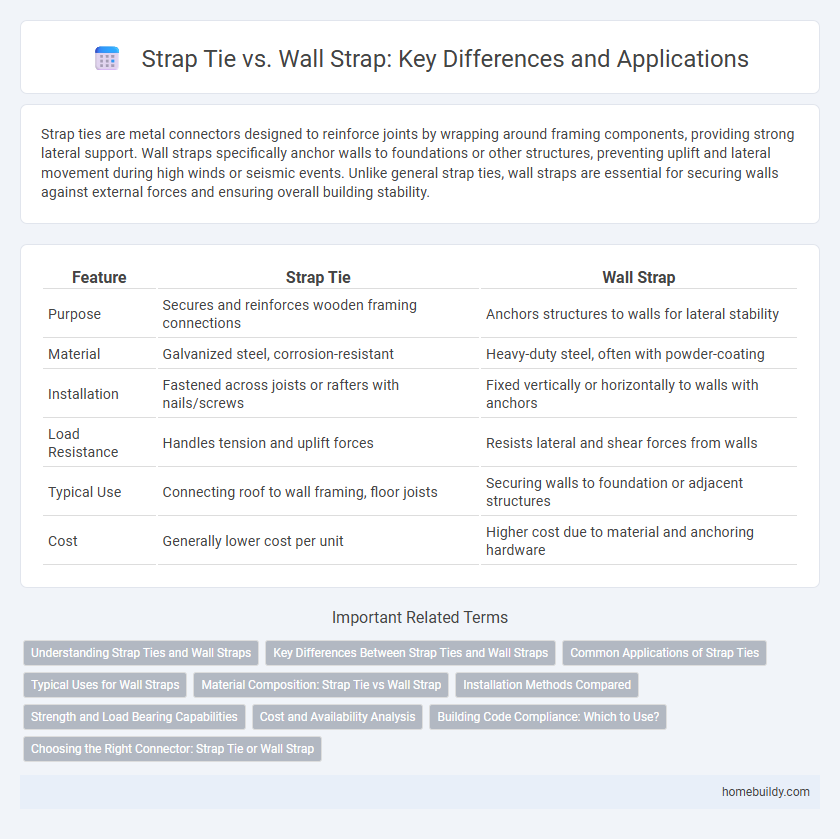Strap ties are metal connectors designed to reinforce joints by wrapping around framing components, providing strong lateral support. Wall straps specifically anchor walls to foundations or other structures, preventing uplift and lateral movement during high winds or seismic events. Unlike general strap ties, wall straps are essential for securing walls against external forces and ensuring overall building stability.
Table of Comparison
| Feature | Strap Tie | Wall Strap |
|---|---|---|
| Purpose | Secures and reinforces wooden framing connections | Anchors structures to walls for lateral stability |
| Material | Galvanized steel, corrosion-resistant | Heavy-duty steel, often with powder-coating |
| Installation | Fastened across joists or rafters with nails/screws | Fixed vertically or horizontally to walls with anchors |
| Load Resistance | Handles tension and uplift forces | Resists lateral and shear forces from walls |
| Typical Use | Connecting roof to wall framing, floor joists | Securing walls to foundation or adjacent structures |
| Cost | Generally lower cost per unit | Higher cost due to material and anchoring hardware |
Understanding Strap Ties and Wall Straps
Strap ties and wall straps serve different purposes in construction, with strap ties primarily used to reinforce the connection between framing members and improve structural stability. Wall straps, on the other hand, are designed to secure walls to foundations or other supports, preventing uplift and lateral movement during high winds or seismic events. Understanding the specific application and load requirements of strap ties versus wall straps ensures optimal safety and compliance with building codes.
Key Differences Between Strap Ties and Wall Straps
Strap ties are metal connectors designed to reinforce wood framing by securing beams and joists, enhancing structural stability and load distribution. Wall straps, in contrast, specifically anchor walls to foundations or other structural elements to resist lateral forces like wind and seismic activity. The key difference lies in their intended application: strap ties primarily brace horizontal framing members, while wall straps secure vertical wall assemblies for improved resistance against displacement.
Common Applications of Strap Ties
Strap ties are widely used in construction to secure framing components, reinforcing connections between joists, beams, and studs to enhance structural stability. Unlike wall straps that primarily anchor walls to foundations, strap ties are ideal for connecting wood members in angled or irregular configurations, providing flexibility in framing applications. Common applications include securing roof trusses, bracing floor systems, and reinforcing gable ends to resist uplift and lateral forces.
Typical Uses for Wall Straps
Wall straps are typically used to secure appliances, furniture, and equipment to walls, preventing tipping and enhancing safety in homes and workplaces. Unlike strap ties that bind materials together, wall straps anchor objects directly to vertical surfaces, providing increased stability during seismic events or accidental impacts. Common applications include securing bookcases, water heaters, and heavy cabinets to minimize hazards and property damage.
Material Composition: Strap Tie vs Wall Strap
Strap ties are commonly made from galvanized steel or stainless steel, ensuring high tensile strength and corrosion resistance for securing structural components. Wall straps typically utilize heavier gauge steel or reinforced metal alloys designed to provide enhanced load-bearing capacity and durability in wall anchoring applications. The material composition of strap ties prioritizes flexibility and ease of installation, while wall straps emphasize robustness and long-term stability under lateral stress.
Installation Methods Compared
Strap ties are typically installed using nails or screws directly through the metal tie into wood framing, providing a straightforward and strong connection. Wall straps often require more precise placement and may utilize specialized fasteners or anchors to secure them to masonry or concrete surfaces. The installation of strap ties is generally quicker and more adaptable to various wood framing scenarios compared to the more complex attachment process required for wall straps on solid wall materials.
Strength and Load Bearing Capabilities
Strap ties offer higher strength and improved load-bearing capabilities compared to wall straps due to their robust design and material composition, which effectively resist tension and shear forces in structural connections. Wall straps primarily provide lateral support with limited tensile strength, making strap ties preferable for applications requiring enhanced resistance to wind uplift and seismic loads. Choosing strap ties over wall straps ensures greater structural integrity and safety in critical load-bearing scenarios.
Cost and Availability Analysis
Strap ties generally offer a lower cost compared to wall straps due to simpler manufacturing processes and widespread availability from multiple suppliers. Wall straps, often customized for specific structural applications, tend to be more expensive and have limited stock in standard hardware stores. The broader market presence of strap ties ensures quicker procurement and better pricing for large-scale projects.
Building Code Compliance: Which to Use?
Strap ties and wall straps both serve to reinforce building structures, but strap ties typically comply with stricter building code requirements due to their higher load resistance and versatility in securing framing components. Building codes often specify strap ties for critical connections where seismic or wind forces must be resisted, whereas wall straps are generally used for less load-intensive tasks such as anchoring siding or lightweight elements. Understanding local building code provisions is essential to determine when a strap tie or a wall strap is appropriate to ensure structural safety and compliance.
Choosing the Right Connector: Strap Tie or Wall Strap
Strap ties and wall straps serve distinct structural purposes in construction, with strap ties primarily used to reinforce connections between framing members and wall straps securing walls to foundations. Selecting the right connector depends on load requirements, material compatibility, and specific building codes, where strap ties offer flexibility in lateral bracing and wall straps provide essential anchorage against uplift forces. Evaluating structural demands and environmental factors ensures optimal safety and performance by choosing the appropriate option for securing walls and framing systems.
strap tie vs wall strap Infographic

 homebuildy.com
homebuildy.com